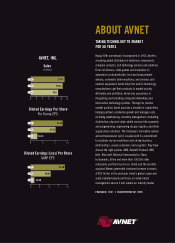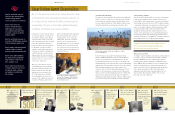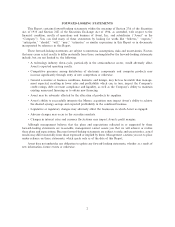Avnet 2005 Annual Report Download - page 3
Download and view the complete annual report
Please find page 3 of the 2005 Avnet annual report below. You can navigate through the pages in the report by either clicking on the pages listed below, or by using the keyword search tool below to find specific information within the annual report.
1921-1940
Charles Avnet and
the Golden Age of Radio
With World War I a memory, New York
City’s docks were awash in surplus
military and ship-to-shore radio parts.
Amateur (ham) radio enthusiasts were
putting together crystal set “cat’s
whiskers” devices of their own from
kits. The market for radio components
was heating up. Into this nascent
industry came Charles Avnet, a 33-
year-old Russian immigrant. He began
buying and selling surplus radio parts
in 1921, just as the first component
stores opened for business on Lower
Manhattan’s Radio Row. As radio
manufacturing grew, so did the role
of parts distributors. Charles sold about
$85,000 in components his first year
in business and soon added automobile
antenna assembly and kits to his
repertoire. When the Depression hit,
he shifted his focus from retailing
to wholesaling radio and television
set parts, an astute decision that
allowed him to pay off all his debts
and realize a modest profit. By making
good on his loans, he was building a
reputation of business acumen and
honesty that would serve his namesake
Company well.
1941-1959
The Connector Connection
Electronic components became priority
defense items as the United States
geared up for World War II. Charles
turned his full attention to satisfying
military and government requests. He
opened his first major manufacturing
facility in 1944 to assemble military
antennas. As the war came to a close,
Charles’ son, Lester, persuaded him
to shift his focus to connectors, which
were not only available for pennies on
the dollar as military surplus, but were
intrinsic to almost every electronic
device. Ten years after the war ended,
the Avnets had a thriving business
manufacturing and assembling
connectors to customers’ specifications.
They incorporated in 1955 as Avnet
Electronic Supply Co. and the following
year opened their first West Coast
facility to serve the aviation and
2005 Annual Report
The Early Years
1921 - Charles
Avnet begins
selling radio
parts in New
York City; Lower
Manhattan’s
Radio Row
takes off
1924 - Commercially
produced, battery-
powered radios are
introduced to an
enthusiastic audience;
half a million sets are
sold, a fivefold
increase over
the previous year
1921 1924 1938 1944 1952 1955 1956 1957
1921-2005
YEAR
-TO-
YEAR
missile industries. In 1957, Bendix
named Avnet an authorized factory
jobber and assembler, Avnet’s first
franchised relationship. Soon renamed
Avnet Electronics Corp., by 1959 the
Company boasted overnight delivery
coast to coast. In addition to connectors,
the line card included capacitors,
fasteners, switches and early
semiconductor products. Avnet
Electronics, with just over $6 million
in sales, closed the decade by going
public on the American Stock Exchange.
1960-1974
Diversify! Avnet Broadens its Horizons
With the commercialization of the
integrated circuit and invention of
the microprocessor, electronics entered
an exciting age of innovation, and so
did Avnet. The Company embarked
on a new era with the purchase of audio
equipment maestro British Industries
Corp., (BIC) a distributor of elite brands
like Garrard turntables and Wharfedale
speakers. It was just the first in a string
of acquisitions that would turn Avnet
from a components distributor and
manufacturer into a company with
expertise in an array of goods, from
microprocessors and die casting
machines to television antennas, musical
instruments, perfume bottles, industrial
engines, auto parts, record albums,
trophies and more. Now a member
of the New York Stock Exchange, the
Company expanded into Canada in
1963 and changed its name to Avnet,
Inc. the following year to reflect the
breadth of its interests. It entered the
big leagues in 1968, joining the Fortune
500 at No. 467. Although the pace of
acquisitions slowed in the 1970s,
Avnet continued to invest in stocking,
manufacturing and sales facility
expansion. Avnet, Inc. had become
a diversified holding company with
a fluid matrix of businesses involved
in distribution, marketing, licensing
and manufacturing activities around the
world. Revenue surpassed $570 million.
1975-1989
Technology Wins the Day
Avnet’s diversified portfolio helped
it trump the economic slump of the
mid-1970s recession, but after some
40 acquisitions in the 1960s it was time
to fine-tune the Company. The strategy
revolved primarily around consolidating
divisions, investing in sales, warehouse
or stocking facilities,
developing new
products,
reinforcing
relationships,
adding new
franchises and
expanding markets.
Avnet’s future would be
in the field from whence it arose –
technology distribution. The Company
was already the leading U.S. distributor
for semiconductors, connectors, computer
products and passive components, and
in many cases it was the single largest
customer of each of its suppliers.
Franchises with Intel, AMD, Fairchild,
Motorola and other semiconductor
suppliers contributed greatly to the
Company’s vigor. By the end of the
decade, sales exceeded $1 billion and
75 percent of revenue came from the
Electronic Marketing and Wire & Cable
groups, which had contributed only 25
percent just 10 years prior. In the late
1980s, sales of personal and business
computers took off. Avnet expanded its
position, taking technology distribution
beyond components to board-level and
development systems, peripherals,
microcomputers, software, servers and
networks. The Video Communications
and Electrical & Industrial groups were
all that remained of Avnet’s non-core
business. Revenue neared $2 billion.
1938 – There are
50 million radio
sets in the U.S.,
up from 33 million
two years prior
1952 – Leon
Machiz founds
Time Electronic
Sales; its first
franchise
is with ITT
Cannon
1955 – Avnet Electronic Supply Co.
incorporates with Robert Avnet
(right) as chairman, Lester Avnet
(left) as president and founder
Charles Avnet (middle) as vice
president and treasurer
1957 – Tony Hamilton
founds Hamilton
Electro Sales
1956 – Avnet opens its
first West Coast facility
in Los Angeles
1944 – Lester Avnet
persuades his father
and brother to turn
their attention to
industrial and
military connectors
1957 – The semiconductor
industry surpasses
$100 million in sales
The Avnet family gathers for the
1951 marriage of Charles Avnet’s
son, Norman, now a retired
radiologist, and his wife, Roz.
Clockwise from top left: Robert
Avnet and his wife, Maxine; Joan
Avnet and her husband, Lester;
Norman and Roz; and Helen Avnet
and her husband, Charles.
From founder Charles
Avnet’s first sale on
Radio Row in the 1920s
to today’s multimillion-
dollar relationships
with leading-edge
companies, Avnet has
been at the center of
the technology industry,
delivering value,
creating solutions
and building channels
to market for our
trading partners.
New York City
Peabody
1956 – Avnet’s sales
surpass $1 million
1990-2000
The World is Your Market
In 1990, Avnet completed an ambitious
centralization and automation plan and
set the stage for a spate of acquisitions
that would redefine the global technology
distribution industry. Stung by a nasty
semiconductor downturn in the mid-1980s,
the Company commenced an infrastructure
overhaul. In five years, the Electronic
Marketing Group metamorphosed from a
constellation of more than 100 full-service
stocking/sales/support facilities into an
efficient collection of technologically
advanced regional megawarehouses and
field support hubs interlaced with a network
of local sales branches. That accomplished,
the Company turned its focus to establishing
a global footprint. The acquisition of the
Access Group in the U.K. in 1991 and
Taiwan’s WKK Semiconductors in 1995
were the first in Europe and Asia. Avnet
averaged almost four acquisitions per year
through 2001 – among them the EBV
Group, Hall-Mark Electronics, the Savoir
Technology Group and Sunrise Electronics
– consolidating the technology distribution
industry and supporting suppliers and
customers as they sought cheaper
manufacturing and new markets for
their products. Avnet’s computer products
business came into its own, surpassing
$1 billion in revenue in 1997 and becoming
a stand-alone operating group, the Computer
Marketing Group, the following year. In
2000, Avnet had a presence in 59 countries
and had surpassed $6.3 billion in revenue.
2001-Present
The Value Creation Era
Precipitated by a slowing world economy,
stunted demand for electronic equipment
and a bloated technology supply chain,
the industry collapsed into an unparalleled
downturn after a roaring millennial start.
Though painful, it prompted Avnet to
rethink its strategy for the 21st century.
For years, the Company had focused
on accounting profit, growing revenue,
capturing market share and creating a
global footprint. Now, it turned its attention
to economic profit. “ROCE!” became the
new battle cry, measuring profit not as
a percent of sales, but as a return on the
capital employed to run the business and
finance growth. By focusing on value-based
management practices, Avnet steadily
increased profit and return on capital
following the downturn. The Company
ended fiscal 2005 with record working
capital velocity in the fourth quarter.
Services and solutions were at the
forefront, making Avnet’s expertise in
logistics, financing, marketing, integration
and a host of other value-added activities
more important than ever.
Certainly, a lot has changed over the past
80 years, but much remains the same.
Whether powering radios, engines or
computers, technology drives the global
economy. Avnet remains committed to
excellence in customer service, driven
not only by an obsessive attention to our
partners’ needs, but by an information
technology capability that allows us to
manage their, and our, business efficiently
and profitably. And, our Company remains
a culture of performance, values and
entrepreneurial spirit, one in which our
people are empowered to make decisions on
the front lines to best serve their customers,
markets and of course, Avnet. We celebrate
the 50th anniversary of our incorporation
this year as the No.1 value-added technology
distributor in the world, and our future is
brighter than ever.
50 YEARS OF MAKING HISTORY
1959 – Avnet goes
public on the
American Stock
Exchange as Avnet
Electronics Corp.
1961 – Wall Street analysts nickname
Avnet “The Darling of the Big Board”;
revenue nears $20 million with $0.70
earnings per share
1962 – Avnet acquires
Hamilton Electro
Sales; eight years later,
Hamilton/Avnet is born
and is soon the nation’s
largest electronic
components distributor
1960 – Avnet completes
its first acquisition,
hi-fi equipment
importer British
Industries Corp.,
and is concurrently
listed on the New York
Stock Exchange
1964 – Avnet Electronics
Corp. is renamed Avnet,
Inc. to reflect the
company’s diversification
1959 1960 1961 1962 1964
Tongeren
Shenzhen
Phoenix
















